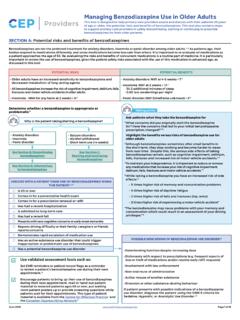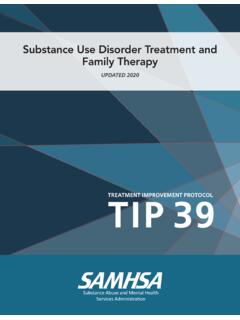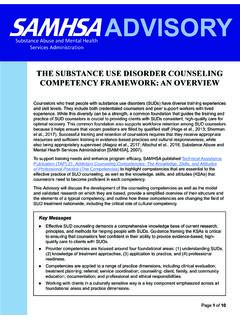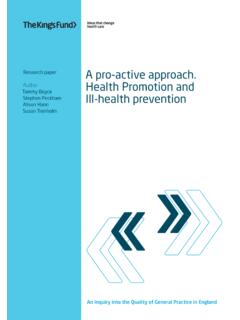Transcription of SBIRT: A Step-By-Step Guide A Step-By-Step Guide for ...
1 SBIRT: A Step-By-Step Guide A Step-By-Step Guide for screening and Intervening for Unhealthy Alcohol and Other Drug Use ABOUT THIS TOOLKIT This toolkit was developed to assist Massachusetts healthcare providers and organizations in implementing regular screening , Brief Intervention and Referral to Treatment (SBIRT) for unhealthy alcohol and drug use in clinics and practices. SBIRT is a quick, easy way to identify and intervene with patients whose patterns of use put them at risk for, or who already have, substance-related health problems. How much time is needed? Most patients (75-85%) will screen negative. Completing three to four simple questions will take one to two minutes. For the remaining fifteen to twenty-five percent of patients, the full screen and brief intervention will take between five and twenty minutes to complete.
2 This toolkit provides: Rationale for routine screening for unhealthy alcohol and drug use as an important component of good healthcare Two recommended screening approaches for alcohol and other drug use A suggested brief intervention script Steps for referring patients to substance use specialty care, when needed Questions to consider for implementing SBIRT Helping Patients Who Drink Too Much: A Clinician s Guide , produced by the National Institute on Alcohol Abuse and Alcoholism (NIAAA). Of particular note, is the section on Prescribing Medications For Treating Alcohol Dependence , as well as suggested strategies to diagnose and help patients with alcohol use disorders. For further information or to arrange SBIRT training and implementation assistance, please contact the Massachusetts Department of Public Health Bureau of Substance Abuse Services SBIRT Coordinator at SBIRT focuses on the large numbers of people who may use alcohol or drugs in unhealthy ways but who do not have a substance use disorder ( , abuse, dependence).
3 Research shows that they can and do successfully change their use with feedback and early intervention. SBIRT also gives positive feedback to those who make healthy decisions. (See footnotes 1,2,3,4) TABLE OF CONTENTS WHAT IS SBIRT? 4 SBIRT components are: 4 What is Unhealthy Alcohol or Drug Use? 5 Risky Drinking 5 Why Universally Screen and Intervene? 6 Before You Begin 6 SBIRT IN ACTION 7 Patients in Recovery 7 SCREEN (S): ASK AND ASSESS 8 Step 1: Ask about alcohol and drug use 8 Scoring 8 Drug Use: 8 Step 2A: If Audit-C positive, assess for alcohol use severity 9 SCORING 9 Step 2B: If single-item drug screen positive, assess for drug use severity 11 SCORING 11 QUICK APPROACH 12 Step 1: Ask about alcohol & drug use 12 Step 2: Assess for alcohol and/or drug severity 12 SCORING 12 BRIEF INTERVENTION (BI) 13 Step 3.
4 Brief Intervention (BI) 13 REFERRAL TO TREATMENT (RT) 16 COMMON TREATMENT MODALITIES THAT MAY BE OFFERED TO PATIENTS 16 SENDING A PATIENT FROM PRIMARY CARE TO DETOX 18 SPECIAL PRIVACY REGULATIONS AND PATIENT CONSENT 18 SUPPLEMENTAL INFORMATION 19 Ten Questions to Consider Before implementing SBIRT 19 CONSENT FOR THE RELEASE OF CONFIDENTIAL INFORMATION 22 SAMPLE NOTICE PROHIBITING REDISCLOSURE 23 BRIEF INTERVENTION QUESTION AND ANSWER 24 MOTIVATIONAL INTERVIEWING OVERVIEW 27 Principles of Motivational Interviewing 27 SBIRT CONSIDERATIONS FOR SPECIAL POPULATIONS 31 REFERENCES 35 What is SBIRT? screening , Brief Intervention and Referral to Treatment (SBIRT) is a comprehensive, integrated, public health approach for early identification and intervention with patients whose patterns of alcohol and/or drug use put their health at risk.
5 SBIRT components are: Universal, annual screening (S) identifies unhealthy use. Seventy-five to Eighty-five percent of patients will screen negative. For those who screen positive, further assessment is needed to determine level of risk. Brief Intervention (BI) provides feedback about unhealthy substance use. It also focuses on education, increasing patient insight and awareness about risks related to unhealthy substance use, and enhances motivation toward healthy behavioral change. Referral to Treatment (RT) helps facilitate access to addiction assessment and treatment. A referral is usually indicated for only about five percent of people screened. Research shows SBIRT to be most effective with patients with unhealthy alcohol or drug use who do not have a substance use disorder.
6 (See footnote 5) Graphic illustrates the following facts, sourced from SAMHSA funded MASBRIT program (N=173, 714): Twenty-five out of thirty people only require screening for patterns of alcohol and drug use Four out of thirty people require a brief intervention One in thirty people require referral to treatment What is Unhealthy Alcohol or Drug Use? Substance use (alcohol and drug) occurs on a continuum from no or low risk use to substance use disorders. Effective interventions are available for people at all points on that continuum. In most cases, unhealthy substance use issues can, and should, be addressed in general healthcare settings. Unhealthy substance use is an all-encompassing term that includes the full spectrum of unhealthy use from: Risky use ( , consumption of amounts that increase the likelihood of health consequences) Substance use disorders ( , abuse and dependence) Some people should not drink at all.
7 For more information about unhealthy alcohol use see page twenty-four and twenty-five of the NIAAA Clinician s Guide included at the back of this toolkit. All use of illegal drugs or misuse of prescription drugs is considered unhealthy use. Risky Drinking For healthy men up to age 65 More than 4 drinks in a day AND More than 14 drinks in a week For all healthy women and healthy men over age 65 More than 3 drinks in a day AND More than 7 drinks in a week As recommended by NIAAA Why Universally Screen and Intervene? Unhealthy alcohol and other drug use are among the most common causes of preventable morbidity and mortality. (See footnote 6.) Despite their frequent presentation in primary care, unhealthy alcohol and other drug use often go unrecognized. While there is substantial research on SBIRT and alcohol, there is less research on SBIRT and drugs.
8 (See footnotes 7 and 8.) Unhealthy substance use can complicate existing chronic conditions like diabetes (see footnote 9), hypertension (see footnotes 10 and 11), cardiovascular diseases or mental health disorders (see footnote 11) and interact with prescribed medications (see footnotes 13 and 14). Research has shown that large numbers of people whose patterns of use put them at-risk of developing alcohol or drug problems can be identified through screening . (See footnote 15.) SBIRT has also been found to: decrease the frequency and severity of drug and alcohol use (footnotes 16 through 18) decrease emergency department visits and hospital days (footnote 19) demonstrate net-cost savings (footnotes 19 through 22) Before You Begin 1. Decide who will do SBIRT ( clinician, support staff) and, if more than one person is involved, determine the process.
9 2. Communicate with your clinic management about how your practice will handle billing potential, documentation requirements and confidentiality regulations. 3. This toolkit was designed to help providers identify unhealthy use, rather than diagnose substance use disorders. For patients who may need further assessment and diagnosis, see NIAAA Clinician s Guide page 7, step 3, or refer to the current version of the DSM. 4. Identify referral resources in your area through your behavioral health staff or by calling the Massachusetts Substance Abuse Information and Education Helpline at 800-327-5050. See the Referral section on p. 11 for more information. Most insurance coverage includes counseling for substance use disorders. 5. See supplemental page 14 for additional considerations for implementation.
10 SBIRT in Action Alcohol only: Go to NIAAA Clinician s Guide located at the back of this toolkit. Alcohol and Drug: (Proceed ahead) We recommend two substance use screening strategies: The Standard Approach on pages five through seven is longer and requires scoring but has been more rigorously tested for validity. We recommend this strategy when incorporating questions into your EMR. The Quick Approach on page eight may be preferable to some as it is easy to memorize, is validated, and can be completed within a few minutes. These questions are like other tests in medical practice and have been validated as such. They may not work as well if altered. Recommended screening and assesment instruments have high sensitivity and specificity. (See footnotes 8, 23, 24, 25, 26, and 27) All practices should routinely incorporate tobacco screening .







